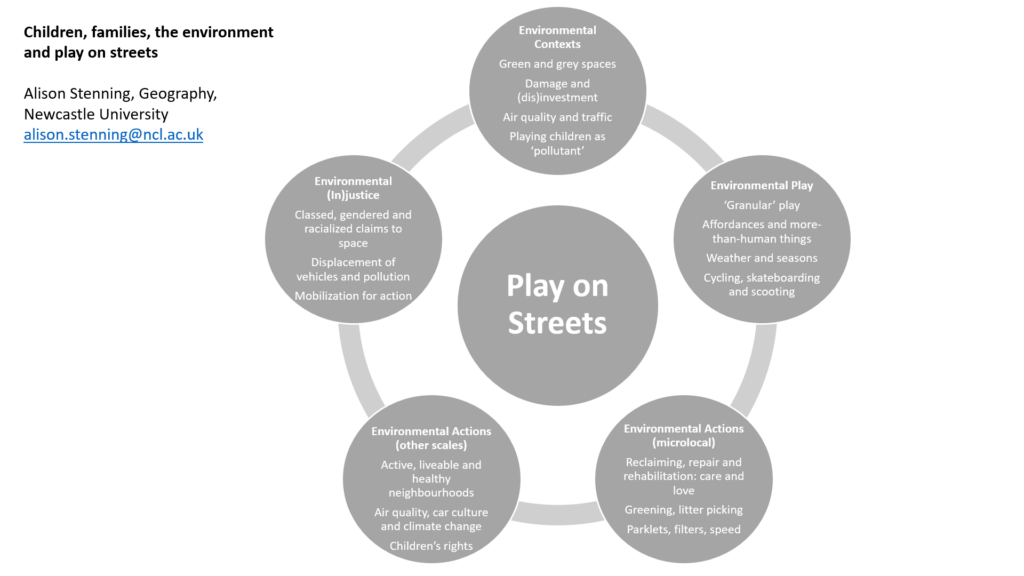
This brief talk [presented at the British Sociological Association’s Family, Relationships and the Environment symposium] reflects on ongoing research and activism around play streets, and play on streets, over the last 7 or 8 years. Some of this is speculative, some autoethnographic, and some derived from research on and with play streets. I’ll talk both about formal ‘play streets’ schemes (where roads are legally closed for a few hours to create space for play) and more informal, autonomous play on streets.
For most of my time researching these issues, my focus has been much more on social space and on questions of social and spatial justice, albeit with a clear commitment to thinking about the materialities of the street, but I am now working to develop a greater focus explicitly on ‘environments’, at a variety of scales and especially on questions of environmental justice and the ways in which play on streets intersects with, enables and challenges questions of environmental justice, at a variety of scales.
In the few minutes I have, I’d like to talk through five intersecting perspectives on play on streets and ‘the environment’ as a means to start to explore these issues; these perspectives connect with ongoing conversations and conceptualisations about grey spaces, common worlds, damage, repair and care, and justice.
- Streets might be seen as archetypal grey spaces – not just made of tarmac and concrete, brick and paving (though perhaps interspersed with green space, both public and private) but also interstitial, ambiguous and undervalued; the quality of these environmental contexts varies enormously in terms of care, damage, and pollution, including the dominance of motor vehicles and their associated risks of slow and fast violence, and scales of investment and disinvestment in public and private spaces on the street. But we know that these are the spaces that children choose to play in – and have done for decades – if they are able to, over and above more distant green, blue – or plastic – spaces of play; and yet playing children themselves are often seen as pollutants, out of place in the street environment.
- In these spaces, children develop forms of play which are entangled with the more-than-human worlds of the street, from granular engagements with the road surface, front gardens, bugs and plants, to moving at different speeds and scales – climbing, running, crawling, scooting – along, around and across the street and its trees, walls, paths, kerbs, its social and environmental affordances for play, experiencing the street in all seasons and all weathers, mapping the spaces, shapes, entanglements, and materialities of the street, and sharing experiences of play with other children of all ages, and with adults who shape and survey children’s play and perhaps remember their own play on their own doorsteps.* Children play on their doorsteps, with more-than-human ‘things’ with complex environmental histories – toys, bikes, balls, and much more. They experience the street with cars displaced (though often as obstacles) and active forms of movement – running, walking, cycling, scooting, skateboarding – valued.
- We see that these kinds of entanglements and experiences – shared on the street and in family and community conversations about the street, both as the children play and back inside in the homes on the street – can open up ways of thinking about and valuing the street for more-than-cars, reimagining the street itself as a space for dwelling, and starting to act to reclaim, repair and care for the street through small acts of greening or litter picking, which then sometimes grow into conversations about more substantial transformations – claiming more space with planters and parklets, slowing and stopping cars with Children Playing signs, or conversations with councillors and campaigners, and imagining the street anew.
- In some places and at some times, these microlocal conversations and actions grow further, and connect with other spaces – to think about creating active, liveable and healthy neighbourhoods where children and their families are safe from environmental and social risks, to challenge the place of cars, car culture and motornormativity, and to think about the environmental and climate questions invoked by challenging cars – emissions, air quality, net zero, for example. And in the space of the street and the community, these can connect to questions of intergenerational responsibility and action, to children’s rights not only to safe spaces for play, but also to safe futures.
- But, as the variety of neighbourhood contexts suggests, these experiences are uneven, and may reinforce inequalities; the capacity to claim space on the street – for children and their adults – is classed, gendered and racialized, in terms both of the nature of the spaces on doorsteps, where risks, obstacles and resources are uneven, and also the very idea that children and their families can claim public space, are entitled to do so. And there are real concerns – although not always reflected in realities – that as some streets (re)claim space for play, for children and adults, the risks of vehicles and pollutants are displaced to neighbouring streets, to others, and to their entangled environments. Yet these challenges and inequalities can themselves mobilize communities for action, to engage with each other and with others locally to connect the different contexts and build bigger campaigns.
Through all these spheres, we can highlight both the complexity and the potential of engagements between children, families and their environments, doorstep and more distant, as they play on their streets.
* The focus in this paper, given the symposium context, was primarily on family relationships but many of these engagements and experiences develop with neighbours, as relationships on the street are transformed by play.
